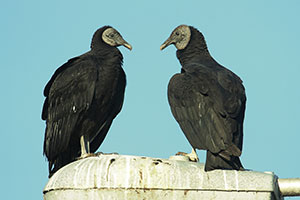 While the American black vulture is certainly not the most beautiful bird in the Everglades or the one with the best reputation, it might be one of the more interesting birds in not only the Everglades, but the entire world. Because the circling of vultures in the sky can often be a sign that something on the ground has just died and is about to be eaten, black vultures have often been associated with death. But while their feeding habits seem to give black vultures an ominous presence over humans, it is also their feeding habits that make them so unique.
While the American black vulture is certainly not the most beautiful bird in the Everglades or the one with the best reputation, it might be one of the more interesting birds in not only the Everglades, but the entire world. Because the circling of vultures in the sky can often be a sign that something on the ground has just died and is about to be eaten, black vultures have often been associated with death. But while their feeding habits seem to give black vultures an ominous presence over humans, it is also their feeding habits that make them so unique.
The black vulture is a well known scavenger, and it has often been stated that a vulture will eat “anything.” Their main source of food is carrion, which is the dead and decaying flesh of animals. It’s no wonder these birds are easily spotted hovering above recent road kill, but they have also been known to make a meal out of the living – namely fresh eggs and newborn animal babies.
In areas populated by humans, the black vulture has been known to feed at garbage dumps, and, because they sometimes feed on livestock as well, this particular bird is not too popular among cattle herders and farmers. Whether or not this interesting bird is well-liked by the human population, it plays an extremely important role in the ecosystem of which it lives, as these birds dispose of carrion that would otherwise serve as a breeding ground for bacteria.
The black vulture gets its name from its deep black plumage, featherless grey-black head, and its short, hooked beak. While it is a relatively large bird with a wingspan of up to 5ft, it is actually considered small in comparison to other vulture species, which can get much larger. The black vulture has excellent eye sight and sense of smell, and, because they often find prey by following other vultures, they can often be seen in large groups. The American black vulture can be found in the Southeastern United States down to Central South America, and is protected in the United States under the Migratory Bird Treaty Act of 1918.
While vultures can be found in the populated areas surrounding the Everglades, they are best observed during an Everglades swamp tour. While humans can easily observe them feeding on trash or roadkill in their neighborhoods, airboat tours through the Everglades allow us to truly witness their natural behavior and feeding habits without human intervention.






